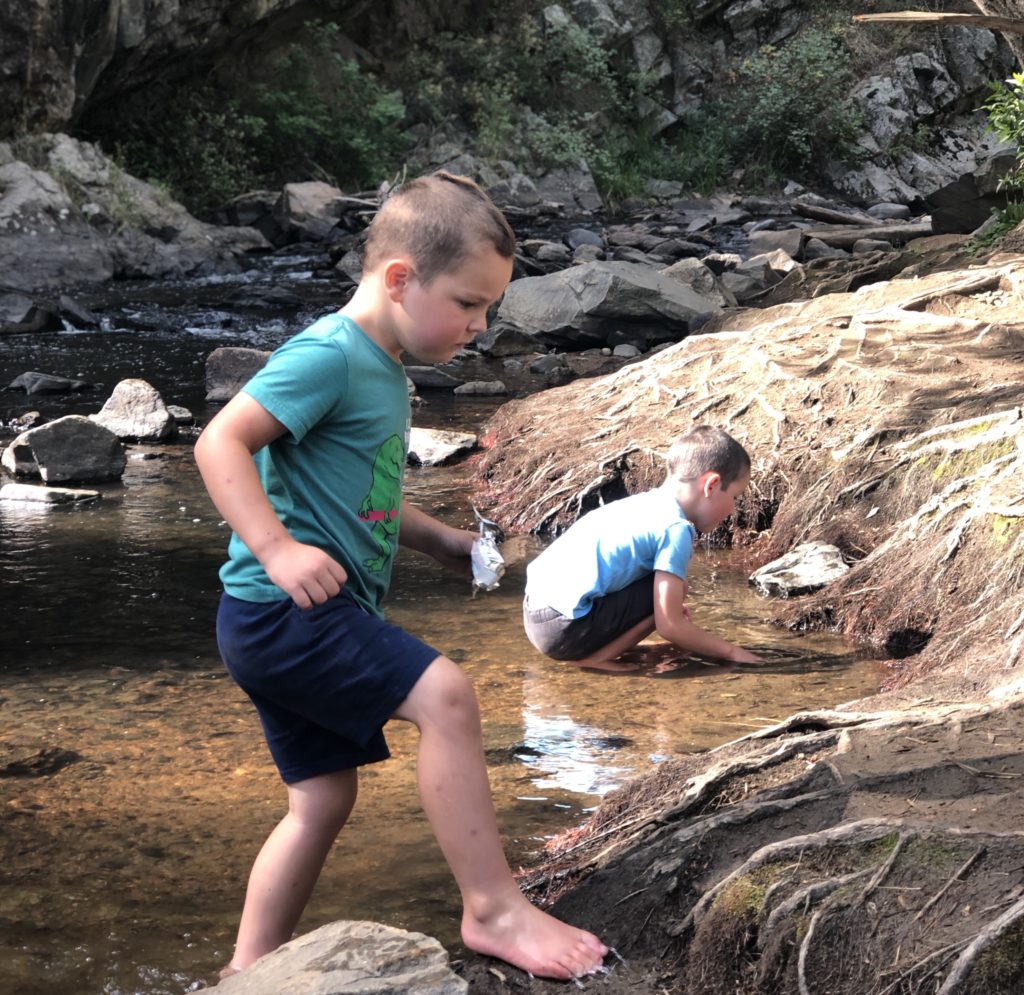Nature play babies toddlers preschoolers Grade School Teens
Nature Play Overview
Nature activities cater to all ages, with toddlers enjoying sensory play, simple scavenger hunts, and water activities. Older children can benefit from more complex activities like building bird feeders, camping, creating nature art, and joining community cleanups. For teens and adults, nature offers opportunities for active pursuits like hiking and biking, learning new skills like birdwatching and orienteering, or engaging in activities that promote mental well-being, such as mindful nature walks and stargazing.
Nature play is engaging in play and exploration in natural outdoor environments such as a park, backyard, forest, field, or beach.
Nature play can include hiking, camping, swimming, or simply exploring the outdoors. For children, nature play activities can consist of the following:
scavenger hunts
star gazing
planting seeds
playing in a mud kitchen
jumping in leaves
digging in the sand
collecting rocks or seashells
walking in a stream
sledding in the snow
searching for bugs
climbing trees
…and so much more!
improving physical health and fitness
reducing stress
instilling a sense of curiosity
stimulating the senses
expanding attention
Get inspired to spend time in nature with these outdoor play quotes.
What Do Children Learn Through Nature Play?
Nature play is an incredible opportunity for children to learn and develop. By immersing themselves in nature, kids can explore interests, push their physical limits through risk-taking play, and engage in sensory-rich learning that brings STEM concepts to life.
Beyond academics, spending time outside expands empathy, instills a sense of environmental stewardship, and nurtures children’s imagination and creativity. Children can freely express their ideas in an unstructured play environment with almost limitless possibilities.
Examples of Nature Play
Children of all ages can participate in nature play. Check out these examples of nature play and discover fun learning ideas for your child or classroom.
Nature Play Ideas for Babies

Keep nature play for babies very simple! At this age, nature play introduces infants to the sensory experiences of spending time outside.
Here are some nature play activities appropriate for babies:
Sensory Nature Walk: Take your baby for a walk outdoors, allowing them to experience a variety of weather, sounds, and smells.
Tummy Time in the Grass: Find a safe, grassy spot for your baby to do tummy time outdoors. Place a blanket or mat on the ground, allowing them to feel the grass and soil while building muscles.
Nature Sensory Bottles: Create nature-themed sensory bottles for your baby. Fill plastic bottles with pinecones, feathers, or leaves, providing visual stimulation and a connection to the natural world.
Water Play: Set up a tray or shallow bin filled with water on a warm day. Allow your baby to splash their hands and feet while exploring the sensations of water.
Nature Sounds Exploration: Sit with your baby outside and listen to nature sounds together. You can support language development by talking about birds chirping, leaves rustling, or gentle breezes.
Nature Treasure Basket: Place 5 to 10 natural objects like seashells, rocks, pinecones, or wooden pieces in a bin. Your baby can explore these items, stimulating their sense of touch. Choose things that are not a choking hazard and supervise this activity closely. Get more treasure basket ideas.
Outdoor Picnic: Set up a cozy outdoor picnic for you and your baby. Spread a blanket under a shady tree, observe the surroundings, and enjoy a snack or meal together.
Nature Play Ideas for Toddlers

Toddlers are ready to participate in hands-on nature play activities. This means more exploring outside and nature-based sensory play indoors too!
Here’s a list of nature play activities perfect for one-year-olds and two-year-olds:
Sensory Nature Walk: Take your toddler on a walk to smell flowers, splash in puddles, touch trees, and listen to birds and rustling leaves.
Leaf Rubbings: Collect leaves while playing outside and bring them home. Place a leaf under a piece of paper and show your toddler how to use crayons to reveal interesting leaf patterns.
Nature Scavenger Hunt: Take off on a nature scavenger hunt! Look for treasures while learning about nature. Check out our nature scavenger hunt templates and blank scavenger hunt templates.
Mud Kitchen: Set up a space for your toddler to dig, mix dirt and water, and make mud creations. You can use a play kitchen or keep it simple with pie pans and kitchen utensils.
Nature Art: Offer your toddler leaves, twigs, or flowers to use as paintbrushes to create nature-inspired artwork.
Bug Exploration: Toddlers are always curious about bugs! Encourage toddlers to be gentle while they observe bugs in a natural habitat. Use bug viewers or magnifying glasses for a closer look. Check out these bee activities for more fun!
Nature Music: Collect natural objects like sticks, rocks, and shells to create a simple instrument set. Invite your toddler to experiment with different ways to make sounds and rhythms.
Nature Sink & Float: Set up a shallow water container or use a kiddie pool outdoors. Provide a collection of natural objects to see what sinks and what floats!
Nature Storytime: Create an immersive reading experience by taking your favorite outdoor play books outside!
Play in the Rain: Toddlers will love the sensory-rich experience of playing outside during a warm rain. They can catch water, splash in puddles, and watch the world around them change.
MORE ON Toddlers In Nature
Nature Play Ideas for Preschool & Kindergarten
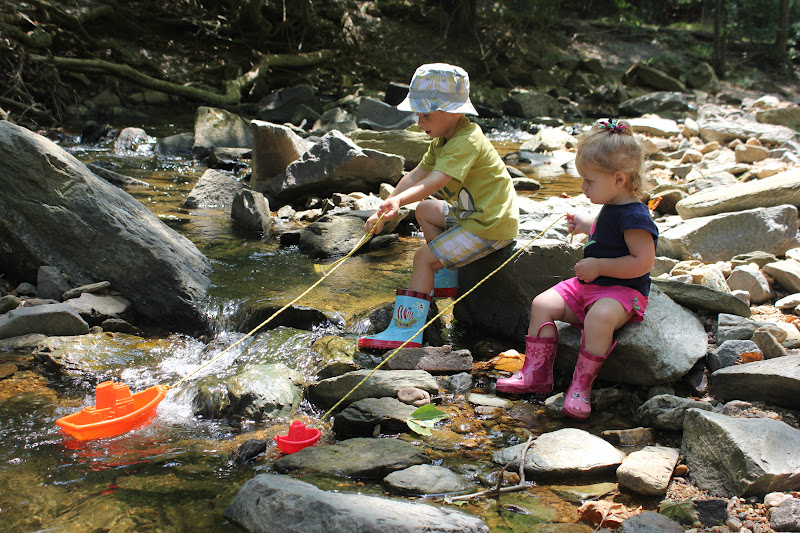
At this stage of play development, children are ready to use props and nature objects to engage deeper in nature play. Preschoolers and Kindergarteners are also ready to learn how humans can help (or hurt!) the environment.
Nature Scavenger Hunt: Create a list of objects found in nature and explore to find or even collect the items. Start with one of our nature scavenger hunts! Save the objects in a sensory bottle or start a nature loose parts collection.
Building Bug Houses: Encourage children to use natural materials like sticks, leaves, and flowers to construct homes for tiny creatures. Children can observe and learn about bugs while also using their imagination.
Sensory Nature Walk: Encourage children to engage their senses by observing and exploring different textures, smells, sounds, and even flavors in nature. Engage the vestibular and proprioceptive senses too through activities like rolling down hills or moving heavy branches or stones.
Nature Art: Provide art supplies like paper, crayons, and watercolors for children to create artwork inspired by nature. Encourage them to draw or paint landscapes, flowers, or animals they encounter.
Nature Storytelling: Children can use nature to inspire storylines, fictional characters, story props, and settings. Find an interesting outdoor space and invite children to create and share stories based on their surroundings.
Outdoor Science Experiments: Children can participate in hands-on experiments outside. Nature studies based on plant growth, butterfly lifecycles, or the water cycle are appropriate learning experiences for young kids.
Nature Field Trips: Visit a local nature park, nature center, urban green space, botanical garden, or nature preservation.
Nature Photography: Introduce early learners to basic photography concepts. Children can use cameras, phones, or tablets to capture photos of plants, wildlife, or natural scenes.
Nature Journaling: Children can carry a notebook or clipboard to document their observations, thoughts, and feelings about the natural world. Invite them to sketch or record their experiences.
MORE ON NATURE PLAY Ages 3 and up
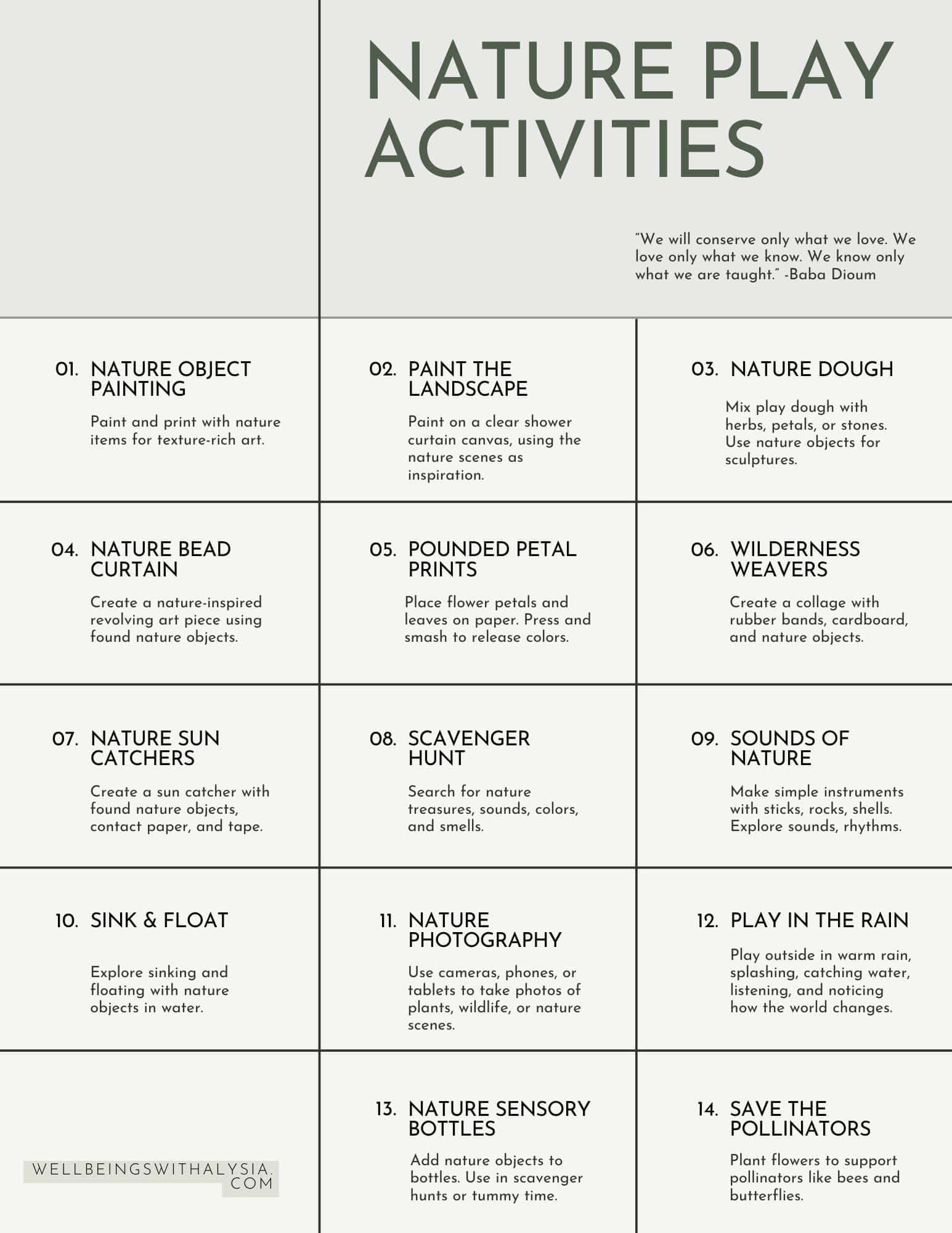
Download the free Nature Play Activities PDF.
Check out this Types of Play post for a comprehensive understanding of childhood play. Elevate your approach to parenting or teaching with expert insights and practical tips.

Nature Play Tips & Safety
Here are some essential safety tips for nature play with children:
Choose age-appropriate environments: Select natural settings suitable for your child’s age and developmental stage. Always actively scan the area for possible hazards.
Dress appropriately: Dress your child in clothing and footwear suitable for outdoor play. Consider the weather and dress children in layers to quickly adapt to weather changes. According to LiveWellWithKrystal.com, protective clothing and safe sunscreen can reduce the harmful effectives of the sun.
Be mindful of allergies: Educate yourself about common allergens in the natural environment, such as specific plants, insects, or pollen. Take precautions if your child has known allergies or sensitivities.
Stay hydrated: Encourage regular water breaks, especially during hot weather or physical activities.
Supervise actively: Always supervise your child closely during nature play.
Teach respect for plants and wildlife: Teach your child to observe wildlife from a safe distance. Talk to children about how to respect animals’ homes and the importance of coexisting harmoniously with nature.
Watch out for poisonous plants: Familiarize yourself with poisonous plants commonly found in your area, such as poison ivy or poison oak.
Check for ticks and other insects: Carefully check your child for ticks or insect bites after nature play. Use insect repellents to minimize the risk of bites.
Be prepared for emergencies: Carry a basic first aid kit with essential supplies during nature outings. Familiarize yourself with basic first aid techniques and be ready to handle minor injuries or emergencies that may occur.
Teach and model responsible behavior: Instill a sense of responsibility and safe behavior in your child. Teach them to respect boundaries, be aware of their surroundings, and make safe choices while playing outdoors.
Whether exploring parks, nature preserves, or even urban green spaces, nature play provides countless opportunities for discovery, investigation, and a deeper connection to the natural world.
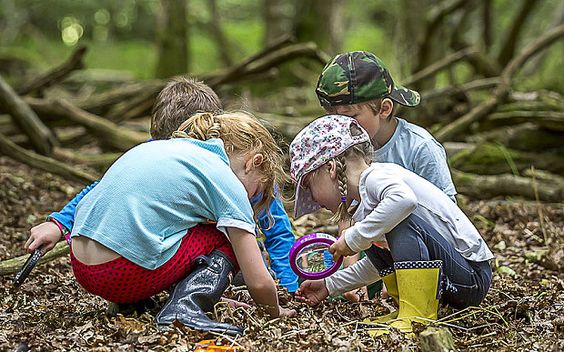
For children aged 5-10, engaging nature activities include going on a nature walk or scavenger hunt, gardening, making nature-based crafts like rock painting or leaf rubbings, exploring insect habitats with a magnifying glass, and having sensory play with water, sand, or mud. Other fun options are bird watching, flying a kite, building an outdoor fort, or creating a fairy garden.
Focus on observation and creativity:
Encourage children to keep a nature journal, filling it with detailed drawings of what they find.Use simple language:
Talk about the different parts of nature, such as trees, flowers, rocks, and sky.Engage with loose materials:
Provide opportunities to play with natural items like sticks, leaves, and stones, which can spark creativity and imagination.
Exploration & Observation Activities
Nature Walk: Take a walk and use your senses to observe trees, flowers, and any wildlife, discussing the different sights, sounds, and smells.
Scavenger Hunt: Create a list of natural items for children to find, such as a red leaf, a smooth stone, or a bird feather.
Bug Hunt: Equip children with a magnifying glass to find and observe insects under rocks, leaves, and on tree trunks.
Bird Watching: Look for birds and listen to their calls using binoculars and sketch pads to document findings.
Sit Spot: Find a natural spot to sit regularly, observing the surroundings and noticing how the area changes over time.
Creative & Sensory Play
Nature Crafts:.Paint rocks, make tree rubbings with crayons, or press flowers and leaves between book pages to preserve them.
Mud Kitchen/Fairy Garden:.Create a "mud kitchen" for imaginative play or build a miniature world in a pot or tub, like a fairy garden.
Sidewalk Chalk Art:.Draw nature-themed pictures, hopscotch grids, or creative designs on a pavement or driveway.
Water and Sand Play:.Set up a sprinkler, play in a sandbox, or simply let kids pour and mix water with toys and containers.
Gardening & Learning
Gardening:.Plant seeds, like sunflowers, and have children measure their growth weekly to learn about plant life cycles.
Herb Garden:.Start a small herb garden and involve children in watering and caring for the plants, which they can then use in cooking.
Seed Paper:.Make and plant seed paper to teach kids about recycling and the process of growing plants.
Active Outdoor Fun
Obstacle Course: Set up an obstacle course using household items like cones, chairs, and ropes for kids to navigate.
Fly a Kite: On a windy day, go outside and enjoy the simple pleasure of flying a kite.
Tree Climbing: Find a suitable tree and enjoy the classic activity of climbing.
Gardening: Plant a garden, giving children ownership of a small plot to plant, tend, and learn about growing.
Look for and try to identify animal tracks in the dirt on nature walks.
Observe birds and listen for their songs, learning about the birds native to your area.
Read related books:
Supplement your nature explorations with age-appropriate nature books to deepen their understanding and curiosity.
NATURE PLAY 10 & UP
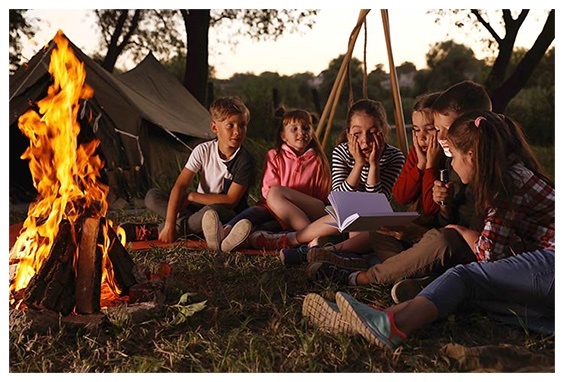
For kids aged 10-13, fun nature activities include organized games like frisbee golf, creative projects like building nature-themed art, or educational pursuits such as birdwatching and stargazing. You can also try activities like hiking and camping, which offer opportunities for adventure and learning, or participate in a community cleanup event to foster environmental stewardship.
Creative Activities
Nature Art & Crafts:.Collect natural items like leaves, stones, and flowers to create art, such as nature mandalas, leaf rubbings, or painted rocks. You can also build a fairy garden, making a miniature world out of natural materials.
DIY Nature-Inspired Crafts:.Build a bird feeder using recycled materials, make a nature weave on a tree stump, or create bead-encrusted stones.
Active & Adventurous Activities
Hiking and Camping: Explore local trails or national parks, and try backyard camping for a simple way to enjoy the outdoors.
Bike Rides: Find a local bike path and enjoy a family bike ride.
Water Activities: Go swimming, or enjoy water play in a park or backyard.
Adventure Parks: For a thrill, visit an adventure park that offers activities like zip-lining and rock climbing.
Educational Activities
Nature Journals & Photography:.Encourage kids to keep a nature journal to document their findings and observe the environment. You can also teach them nature photography by providing a camera or smartphone.
Birdwatching:.Go birdwatching to identify different species using binoculars and learn about their features.
Nature-Based Technology:.Use nature exploration apps to identify plants, insects, and animals, or learn basic wilderness survival skills.
Games & Sports
Scavenger Hunts: Create a list of natural items for kids to find in your surroundings.
Outdoor Games: Play games like frisbee golf, tennis, or kickball in a park or field.
Obstacle Courses: Set up an obstacle course in the backyard for a fun way to get kids moving.
Environmental Activities
Community Cleanups:Volunteer for a local cleanup event to teach kids the importance of protecting the environment.
Gardening for Wildlife:Plant native flowers and plants in your backyard to attract local wildlife like birds and butterflies.
MORE ON NATURE PLAY Ages 10 and up
Nature Play for Teens
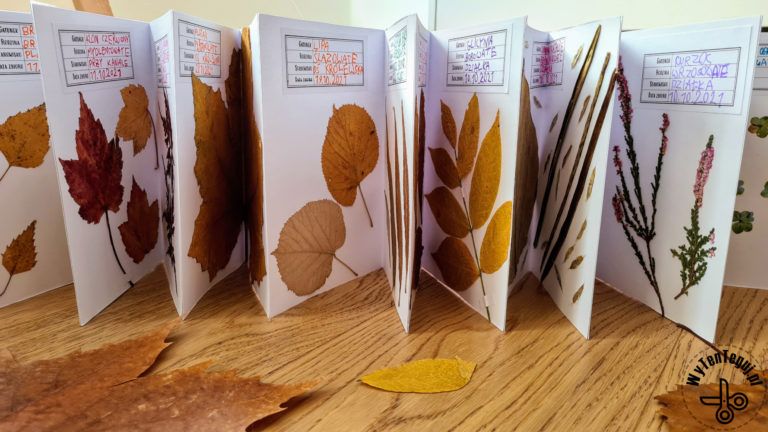
For teenagers aged 13-18, popular nature activities include outdoor sports like biking, swimming, and tennis, engaging in creative and artistic pursuits like nature art and photography, participating in community-focused activities such as environmental clean-ups and community gardens, and exploring scientific interests in nature like birdwatching, foraging, or exploring and collecting in nature's habitats. You can also encourage more active fun like obstacle courses or water balloon fights, or quieter pursuits such as stargazing, cloud watching, or going on a nature walk.
Active & Adventurous Activities
Go on a bike ride or hike: Explore local trails and parks on a bike or by foot.
Play tennis or disc golf: These sports can be enjoyed on a local court or in a public park.
Visit an adventure park: Try zip-lining, ropes courses, or rock climbing for an adrenaline rush.
Go swimming or have a water balloon fight: Perfect for hot days, with options from pools to lakes or even a backyard water park.
Build a backyard obstacle course: Design a challenge course using natural elements like logs and stones.
Go camping: Spend a night at a local campsite or a national park for a more immersive experience.
Creative & Artistic Pursuits
Create nature art:.Collect leaves, flowers, or twigs to make collages, paint rocks, or create temporary land art.
Go beachcombing or collect natural materials:.Look for unique shells, feathers, or interesting stones.
Try nature photography:.Use a camera or smartphone to capture images of wildlife, plants, and landscapes.
Build a fairy house:.Gather natural items to construct a small, whimsical house for bugs or imaginary friends.
Scientific & Exploratory Activities
Go birdwatching or nature surveying: Learn to identify local birds or participate in citizen science projects to count wildlife.
Try geocaching: Use a mobile device to find hidden outdoor locations, combining technology with a treasure hunt.
Go foraging: Learn to find edible plants like wild berries or other plants in your local area.
Create a terrarium or jam jar garden:Use collected materials, soil, and plants to create a mini-ecosystem.
Stargaze: Find a spot with low light pollution and use a stargazing app to identify stars and constellations.
Community & Volunteer Activities
Participate in an environmental clean-up: Join a local organization to help tidy up parks or public spaces.
Start or join a community garden: Grow fresh food together with neighbors.
Volunteer at an animal shelter: Help with tasks like feeding or walking animals.
MORE ON Nature Play for Tweens and up
Nature play inspires conservation and environmental stewardship, starting in a kid’s own backyard adventures. Parents and educators can involve kids in local conservation efforts, empowering them to make a real impact in their communities.
